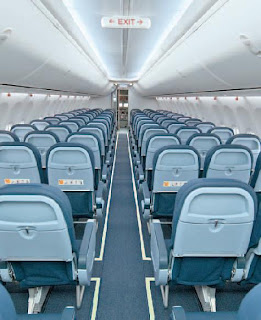"Dual
feather winglet."
This is the new solution proposed by Boeing
for the new 737MAX. The
winglet on the 737 MAX will have two tips, one bending up, the other
down.
"Incorporating
this advanced technology into the 737 MAX design will give our
customers even more advantage in today's volatile fuel-price
environment," Jim Albaugh, president of Boeing Commercial
Airplanes, said in the statement. Boeing launched
the upgraded 737 MAX last August to compete with the A320 new engine
option, or A320neo,
which rival Airbus announced
in late 2010. Both re-engined single-aisle jets are expected to offer
improved fuel savings.
In
2009, Airbus announced it would offer fuel-saving wing tips
that the company calls "sharklets" as an option on the
A320. The neo adds winglets — Airbus calls them "sharklets"
— to the current A320 design, but they are very similar to the
upward swooping winglets on today's 737s.
Because
the 737 already has winglets, Airbus executives have argued that the
MAX cannot gain the extra 3.5 percent fuel-burn improvement the
European plane-maker will gain by adding winglets to the neo.
Wednesday's announcement of a radical new Boeing winglet design
undercuts that argument. Boeing
had previously claimed a 5 percent fuel-burn advantage over the neo.
Spokeswoman Lauren Penning said the new MAX wingtip's incremental
fuel-burn advantage adds up to a further 1.5 percent advantage
compared with the neo. Airbus hotly disputes Boeing's figures. Before
news of the "dual feather" winglet, Airbus had been
claiming the neo would burn 8 to 11 percent less fuel than the MAX,
depending on which sub-models are compared.
Airbus
spokeswoman Mary Anne Greczyn said Wednesday the company's engineers
looked at the option of a split-tip winglet for the neo but decided
on the "sharklet" design. Separately, Boeing revealed that
the MAX will require a slight bump in the door of the nose landing
gear. That's because the nose gear must be extended by 8 inches,
compared with the current 737, to lift the wing and allow sufficient
ground clearance for the new, bigger CFM engines. To fit the longer
nose gear into the wheel well without major structural changes,
Boeing is shaping the landing-gear door so that it bulges outward to
accommodate the tires. That will add some drag, but Teal said the
impact is "negligible." The projected fuel-burn improvement
takes into account all the changes, negative and positive.Airbus has
produced the first new-build A320 with Sharklets. Depicted here at
its roll-out in Toulouse, MSN 5098 will be one of several A320 Family
aircraft in the certification flight-test campaign starting in May
this year and lasting around 600 flight hours. These Sharklet tests
follow the successful ‘early flight-test’ campaign with Airbus’
A320 MSN 001 test aircraft.
In
a conference call with journalists, Michael Teal, chief project
engineer for the 737 MAX, called the concept "the most advanced
wingtip technology in the single-aisle market." The design is
innovative. No commercial airplanes in service today have anything
similar, though the concept resembles a split-tip winglet design
Seattle-based Aviation Partners is flight testing. Winglets in
general add extra wing surface without extending the overall wing
span. They increase the wing's lift while their shape reduces the
drag caused by air vortices at the wingtip. Teal said the split ends
of the new wingtip maximize the aerodynamic gain without adding as
much weight as a longer, single winglet would.
The
overall MAX wing span will be just a few inches longer than the
current 737. Teal said the upper feather of the new winglet is close
to the size of today's 737 winglets, which are nearly 8 feet tall.
The lower feather will be shorter to ensure sufficient ground
clearance. Boeing aerodynamicists came up with the design using
computer simulations, then tested it in two advanced wind tunnels,
Teal said.
He
said the new winglets can be incorporated into the overall design
within the previously announced schedule, which will see the MAX
enter service in 2017. Final details for the jet's design and
manufacturing will be pinned down next year. Last fall, at a Las
Vegas business-jet conference, a somewhat similar design called the
Blended Split-Tip Scimitar Winglet was showcased by Aviation
Partners, which pioneered winglet technology and works with Boeing in
a joint venture that produces winglets for the 737.













